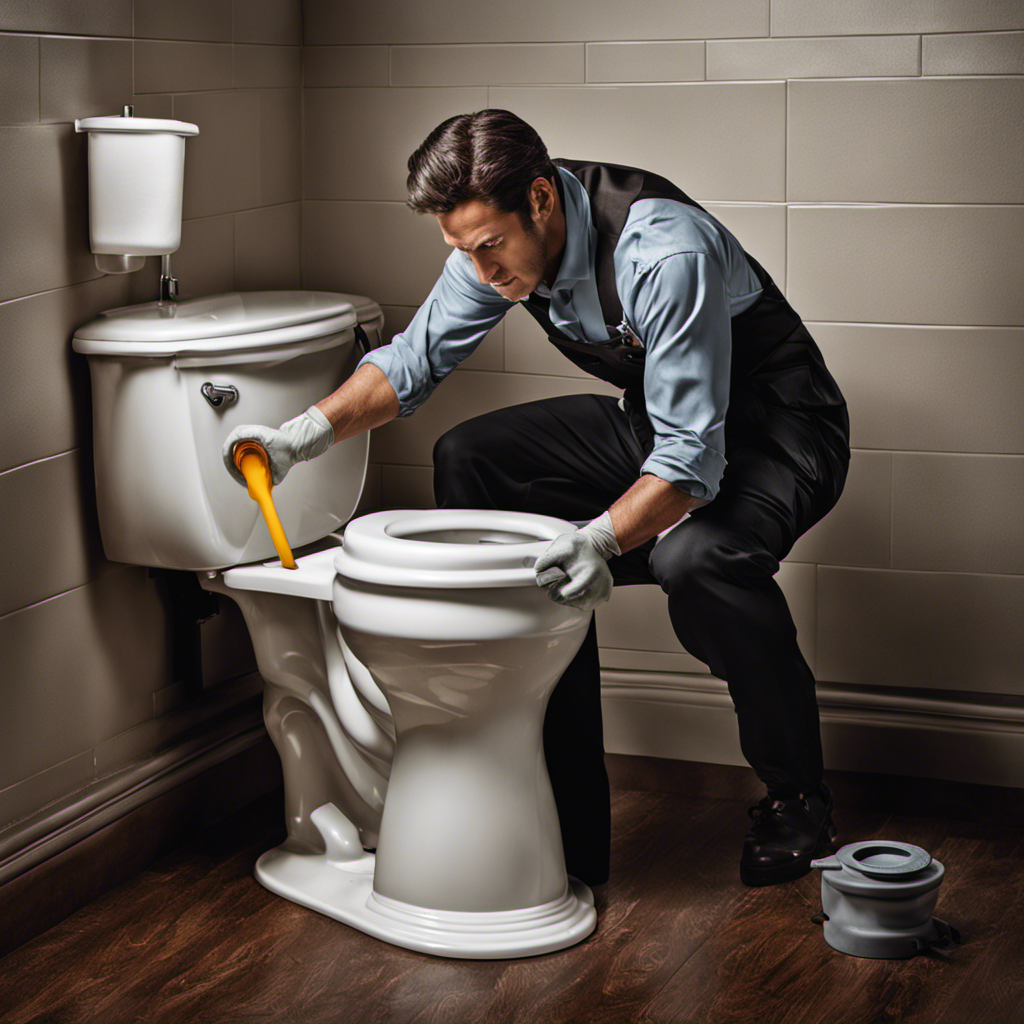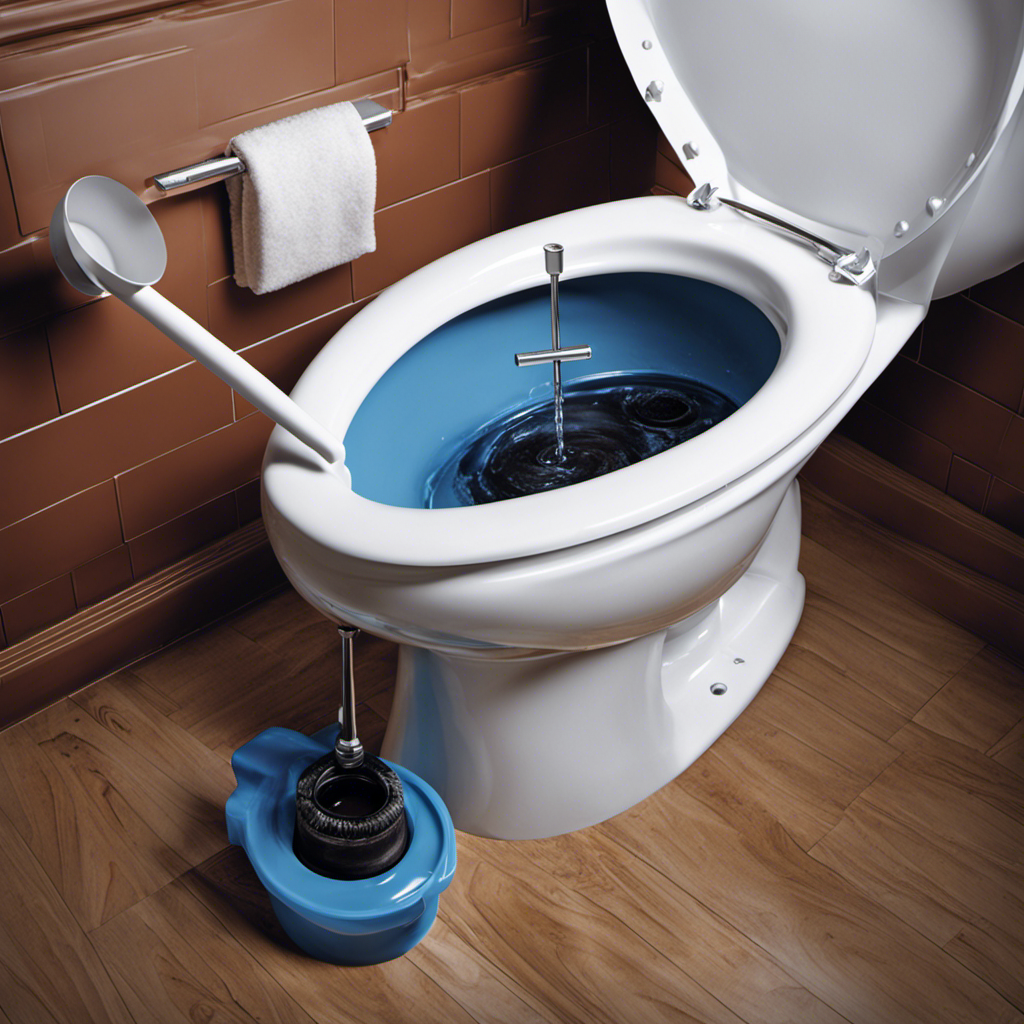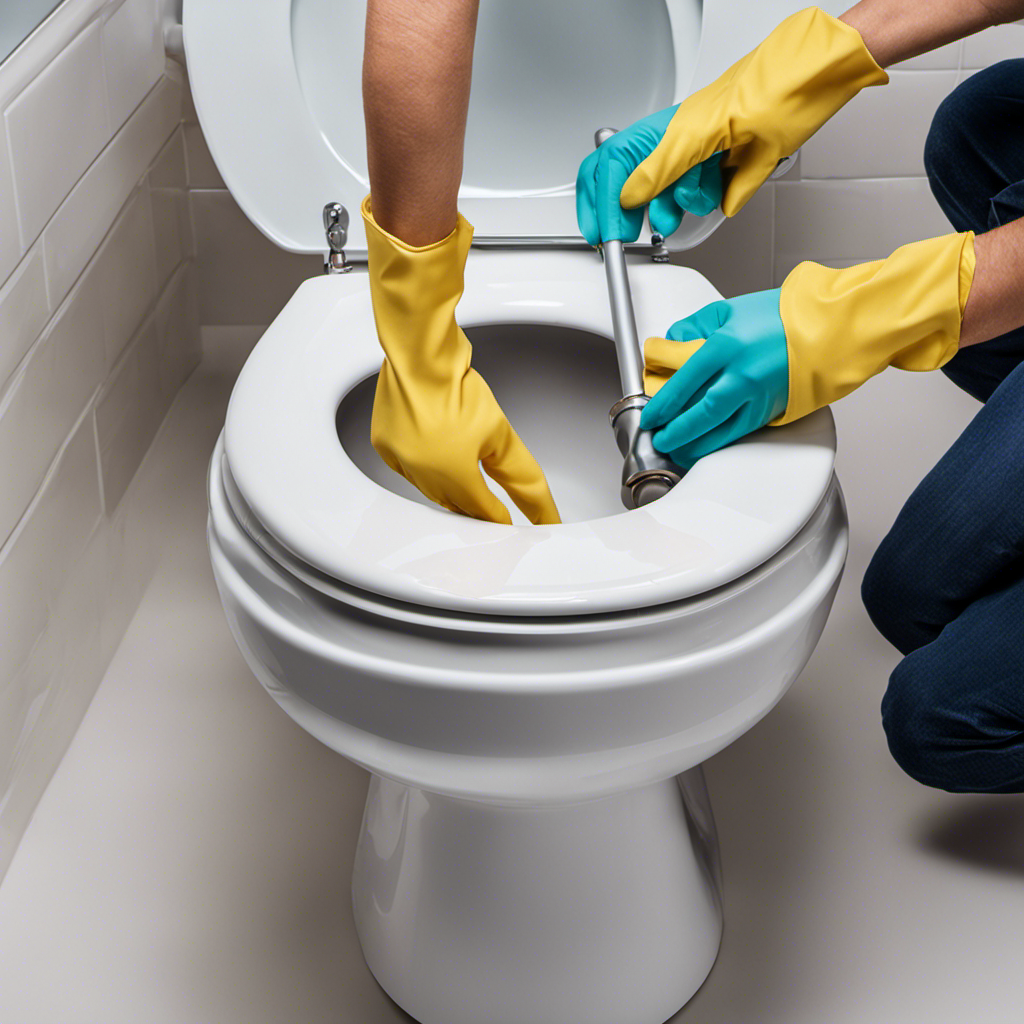I’ll show you how to fix an overflowing toilet with simple, practical steps.
As someone who has experienced this frustrating situation before, I understand the urgency of resolving it quickly.
In this article, I’ll guide you through the process, from assessing the severity of the overflow to restoring proper functionality.
By shutting off the water supply, clearing blockages, and using tools like a plunger or toilet auger, you’ll be able to fix the issue and prevent future overflows.
Let’s get started!
Key Takeaways
- Understanding the common causes and severity of toilet overflow
- Shutting off the water supply to prevent further damage
- Clearing the blockage using methods like plungers, plumbing snakes, hot water and dish soap, or enzyme-based cleaners
- Seeking professional help if the blockage persists or if uncomfortable attempting clearing methods
Understanding the Causes of Toilet Overflow
To understand why your toilet is overflowing, you’ll need to consider a few possible causes.
One common cause is a clog in the drainpipe. This could be due to flushing excessive toilet paper, sanitary products, or even foreign objects.
Another cause could be a malfunctioning flapper valve or fill valve, which can lead to an improper flushing and water overflow.
Additionally, a blocked sewer line or septic tank issue can also result in a toilet overflow.
It’s important to assess the damage and determine the severity before taking any action.
In some cases, you may be able to fix the problem yourself by using a plunger or a plumbing snake.
However, if the issue persists or if you’re unsure of how to proceed, it’s best to find professional help to avoid further damage and ensure a proper fix.
Assessing the Severity of the Overflow
Before determining the best course of action, it’s important to gauge the extent of the toilet’s overflow. Evaluating the damage will help in deciding the appropriate steps to take in fixing the problem. Here are three key points to consider when assessing the severity of the overflow:
-
Check the water level: Look at how high the water has risen in the toilet bowl. If it’s just a small amount, you may be able to handle the situation on your own. However, if the water is near the rim or overflowing onto the floor, it’s best to call a professional plumber.
-
Inspect for any leaks: Take a close look at the surrounding area to see if there are any signs of water leakage. This will help determine the extent of the damage and whether additional repairs are needed.
-
Clean up the mess: While evaluating the overflow, it’s essential to start cleaning up the mess to prevent further damage. Use gloves, disinfectants, and towels to wipe away the water and sanitize the area.
Assessing the severity of the overflow is crucial in determining the next steps to take in fixing the problem. Once you have a clear understanding of the damage, it’s time to move on to shutting off the water supply.
Shutting Off the Water Supply
First, you need to locate the water shut-off valve in order to stop the flow of water and prevent any further damage. The shut-off valve is typically located behind or near the toilet. It is a small valve that you can turn clockwise to shut off the water supply.
If you can’t find the shut-off valve near the toilet, you may need to locate the main water shut-off valve for your entire house. This valve is usually located in the basement or utility room. Once you’ve found the shut-off valve, turn it clockwise until it is fully closed. This will stop the flow of water to the toilet, preventing any more water damage.
Now that the water supply is shut off, you can move on to clearing the blockage in the toilet.
Clearing the Blockage in the Toilet
When it comes to clearing a blockage in the toilet, it’s important to understand the common causes of the blockage and the effective clearing methods available.
Common causes of blockage can include excessive toilet paper usage, flushing foreign objects, or a buildup of waste and debris over time.
To effectively clear the blockage, one can use a plunger to create suction and dislodge the clog, or utilize a plumbing snake to physically remove the obstruction.
Common Causes of Blockage
To unclog your overflowing toilet, you’ll want to know the common causes of blockage. Understanding what can lead to a blocked toilet can help you take preventive measures to avoid future issues.
Here are the common causes of blockage:
- Excessive toilet paper: Using too much toilet paper can cause it to accumulate and create a blockage.
- Flushing non-flushable items: Flushing items like baby wipes, sanitary products, or cotton balls can lead to a clogged toilet.
- Build-up of debris: Over time, debris such as hair, soap scum, and mineral deposits can accumulate in the pipes, causing a blockage.
While preventive measures can reduce the chances of a blockage, sometimes professional assistance is necessary. If you’ve tried clearing the blockage on your own but it persists, it’s recommended to seek professional help.
With a clear understanding of the common causes of blockage, we can now move on to effective clearing methods.
Effective Clearing Methods
Now that we understand the common causes of toilet blockage, let’s move on to effective clearing methods to prevent toilet overflow. In some cases, you may be able to fix the problem on your own with a few simple steps. Here is a table outlining some of the most effective methods:
| Method | Steps |
|---|---|
| Plunger | 1. Place the plunger over the drain hole. 2. Push and pull vigorously to create suction. 3. Repeat as necessary. |
| Plumbing Snake | 1. Insert the snake into the drain. 2. Rotate the handle clockwise to break up the blockage. 3. Pull out the snake and dispose of any debris. |
| Hot Water and Dish Soap | 1. Pour a pot of hot water mixed with dish soap into the toilet bowl. 2. Let it sit for a few minutes. 3. Flush the toilet to clear the blockage. |
| Enzyme-based Cleaner | 1. Pour the recommended amount of cleaner into the toilet bowl. 2. Let it sit overnight. 3. Flush the toilet to clear the blockage. |
| Professional Plumbing Assistance | If all else fails or if you are uncomfortable attempting the clearing methods yourself, it is best to seek professional plumbing assistance. They have the expertise and tools to effectively clear the blockage and prevent toilet overflow. |
Using a Plunger to Unblock the Toilet
Using a plunger is the quickest and most effective way to unblock a toilet. When faced with a clogged toilet, it’s important to act fast to prevent any potential overflow. Here are three key tips to help you successfully use a plunger and avoid a messy situation:
-
Make sure you have the right plunger: Choose a toilet plunger with a flange, which is specifically designed for toilets. This shape creates a better seal and increases the effectiveness of the plunging action.
-
Use proper technique: Place the plunger over the drain hole, ensuring a tight seal. Use firm, controlled plunging motions, pushing down firmly and then pulling up forcefully. Repeat this several times until the water starts to drain.
-
Consider alternative methods: If the plunger doesn’t work, don’t panic. You can try using a mixture of hot water and dish soap to break down the clog. Alternatively, a plumbing snake or a wet/dry vacuum can be used for more stubborn blockages.
Now, let’s move on to using a toilet auger to remove deeper blockages.
Using a Toilet Auger to Remove Deeper Blockages
If the plunger doesn’t work, don’t worry – you can try using a toilet auger to remove deeper blockages. A toilet auger is a handy tool specifically designed for tackling stubborn clogs that a plunger can’t handle.
To properly maintain a toilet auger, ensure that it is stored in a clean, dry place to prevent rusting. Regularly check the auger’s cable for any signs of damage or wear, and replace it if necessary.
When using a toilet auger, insert the cable into the toilet bowl’s trap and rotate the handle clockwise, applying gentle pressure. This motion helps to break up the blockage and allows the auger to grab and remove it.
Restoring Proper Functionality and Preventing Future Overflows
To prevent future problems, regular maintenance and careful usage of your toilet are essential. Here are some tips to help you maintain proper toilet function and prevent future incidents:
-
Regularly inspect your toilet for any visible signs of damage or leaks. Look for cracks, loose connections, or worn out parts.
-
Avoid flushing items that can clog the toilet, such as sanitary products, wipes, or excessive amounts of toilet paper. Dispose of these items in the trash instead.
-
Be mindful of the amount of toilet paper you use. Excessive use can lead to clogs and overflows.
-
Consider installing a toilet fill valve with an adjustable float. This will help regulate water levels and prevent overflows.
-
If you notice any issues with your toilet, address them promptly to prevent further damage or potential overflows.
Frequently Asked Questions
Should I Use Chemical Drain Cleaners to Clear a Blocked Toilet?
I wouldn’t recommend using chemical drain cleaners for a blocked toilet. There are alternative methods, like using a plunger or a toilet auger. If the issue persists, it’s best to call a plumber for professional help.
Can I Fix an Overflowing Toilet Without Shutting off the Water Supply?
When it comes to fixing an overflowing toilet without shutting off the water supply, there are alternative methods you can try. Let me share some practical solutions that can help resolve this issue.
How Can I Prevent Future Toilet Overflows From Happening?
To prevent future toilet overflows, it’s important to understand what causes them. Common causes include clogs, faulty flapper valves, and high water pressure. Regular maintenance, avoiding flushing non-flushable items, and using a plunger when needed can help prevent these issues.
Is It Safe to Use a Plunger if the Toilet Is Still Overflowing?
Yes, it’s safe to use a plunger if the toilet is still overflowing. However, if you’re uncomfortable using a plunger, there are plunger alternatives available. If the problem persists, it’s best to call professional plumbing services.
Can I Use a Toilet Auger to Remove a Blockage if I Have Never Used One Before?
Yes, you can use a toilet auger to remove a blockage even if you have never used one before. It’s important to learn proper toilet auger techniques and avoid common mistakes to ensure success.
Conclusion
In conclusion, fixing an overflowing toilet may seem like a daunting task, but with the right knowledge and tools, it can be resolved quickly and efficiently.
By shutting off the water supply and clearing the blockage using a plunger or toilet auger, you can restore proper functionality and prevent future overflows.
Remember, a clogged toilet is not just an inconvenience, but a potential disaster waiting to happen. So, take action and be prepared to tackle this common household problem head-on.










